Seychelles is a small archipelago of 115 islands situated in the Indian Ocean off the coast of East Africa. It is home to a wide variety of bird species, both native and migratory.
These birds range from the tiny sunbird to the majestic frigate bird and the colorful tropicbird. The Seychelle’s unique location and topography mean that it is a haven for bird-watching enthusiasts from around the world.
Whether you are a professional bird watcher or a beginner, the diverse birdlife of Seychelles will provide you with an unforgettable experience.
1. Seychelles Paradise Flycatcher
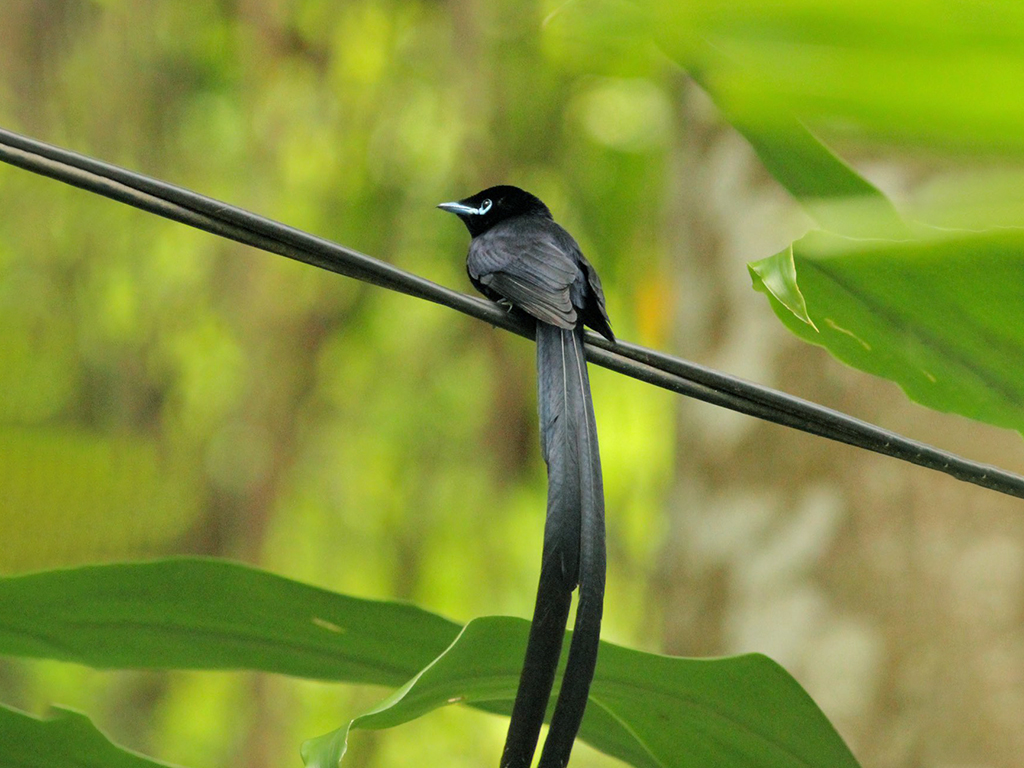
The Seychelles paradise flycatcher is a rare and beautiful bird that can only be found on the island of La Digue in the Seychelles.
It has glossy black plumage with long tail feathers, which males use to attract mates during courtship displays.
Females are reddish-brown with pale underparts and lack these distinctive tail feathers. The species prefers forest habitats, where they feed mainly on insects such as butterflies and moths caught mid-flight.
With its striking colouration and unique endemic habitat, this highly sought after species continues to captivate both local residents and visiting tourists alike.
Scientific classification:
| Kingdom | Animalia |
| Phylum | Chordata |
| Class | Aves |
| Order | Passeriformes |
| Family | Monarchidae |
| Genus | Terpsiphone |
| Species | T. corvina |
2. Seychelles Bulbul
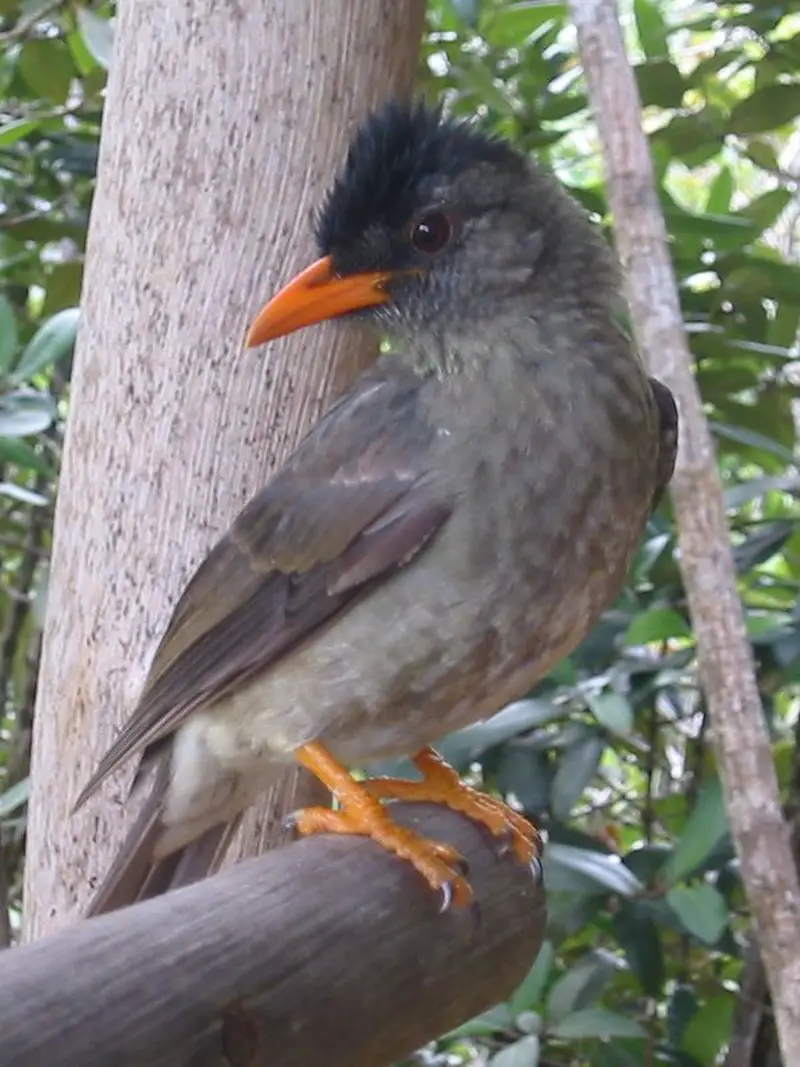
The Seychelles bulbul is a member of the passerine family, found only in the Seychelles islands. With its black plumage and thick yellow bill, it stands out among other birds on Mahé, Praslin and La Digue as well as some smaller islands.
It has an alternative name – ‘the Thick-billed Bulbul’ – referring to its robust beak which suggests that diet may consist mostly of fruit.
The species is closely related to both Grand Comoro bulbuls from neighbouring countries but can distinguished by their distinctive calls.
As an endemic bird species they are particularly vulnerable due to habitat loss; however conservation efforts have seen population numbers sustainably remain stable over recent years.
Scientific classification:
| Kingdom | Animalia |
| Phylum | Chordata |
| Class | Aves |
| Order | Passeriformes |
| Family | Pycnonotidae |
| Genus | Hypsipetes |
| Species | H. crassirostris |
3. Red Fody
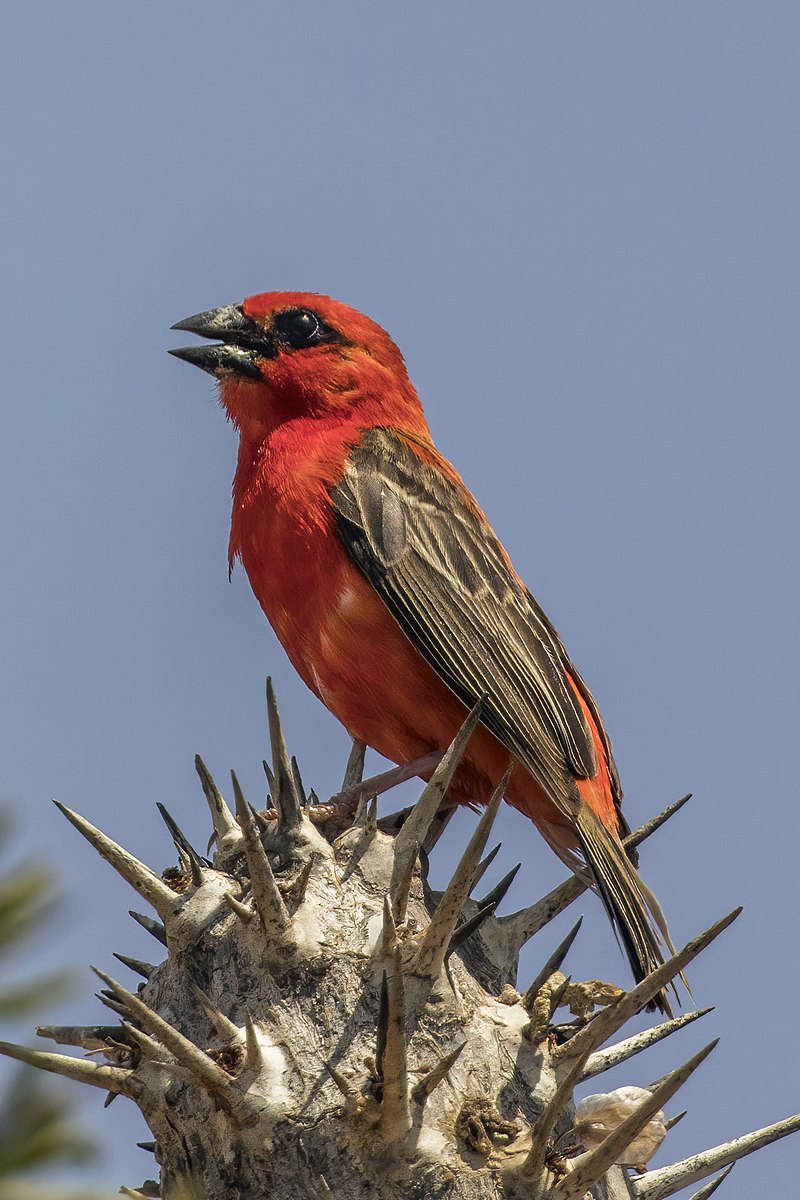
The Red Fody is a small bird native to Madagascar and introduced to other islands in the Indian Ocean.
It has an attractive red plumage and can be seen in various habitats, including grasslands, forests, scrubland as well as urban areas.
Though widespread throughout its range, it is still considered vulnerable due to human activity leading to habitat destruction.
The International Union for Conservation of Nature (IUCN) have assessed this species’ conservation status at “least concern” because of their high population numbers despite ongoing threats like deforestation and over-hunting by humans.
It feeds on insects but also enjoys eating fruits like figs and mangoes which makes them popular with farmers near crop fields.
Scientific classification:
| Kingdom | Animalia |
| Phylum | Chordata |
| Class | Aves |
| Order | Passeriformes |
| Family | Ploceidae |
| Genus | Foudia |
| Species | F. madagascariensis |
4. Seychelles Warbler
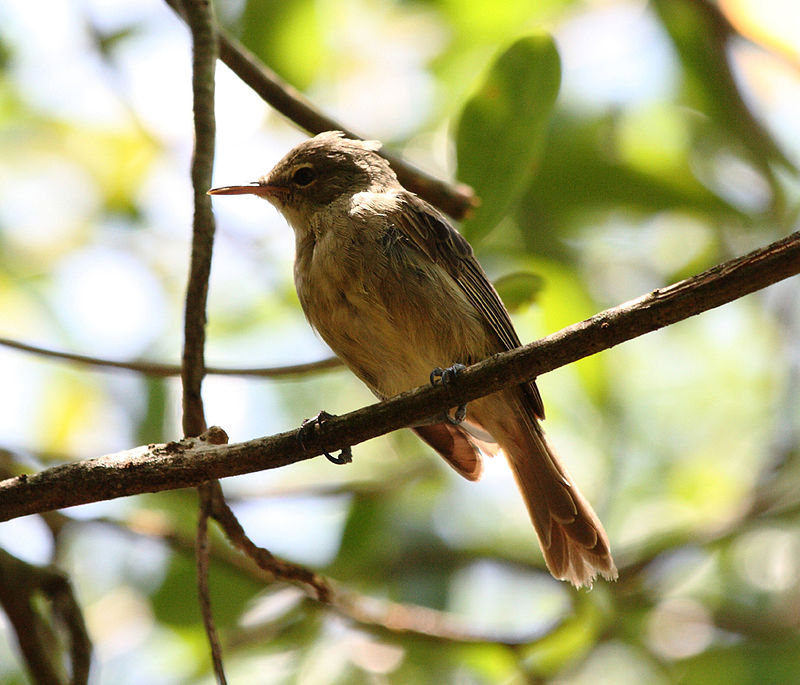
The Seychelles warbler is a small songbird found on five granitic and corraline islands in the Seychelles. It has greenish-brown feathers, long legs, and a slender bill.
This bird primarily inhabits forests but is also known for its cooperative breeding behavior or alloparenting, where individuals raise offspring that are not their own.
The population of these birds have been declining due to habitat destruction from human development activities such as deforestation and urbanization.
As a result, conservation efforts have been initiated by governments to protect this species from extinction; however more research needs to be done assess the effectiveness of these strategies.
Scientific classification:
| Kingdom | Animalia |
| Phylum | Chordata |
| Class | Aves |
| Order | Passeriformes |
| Family | Acrocephalidae |
| Genus | Acrocephalus |
| Species | A. sechellensis |
5. Seychelles White-Eye
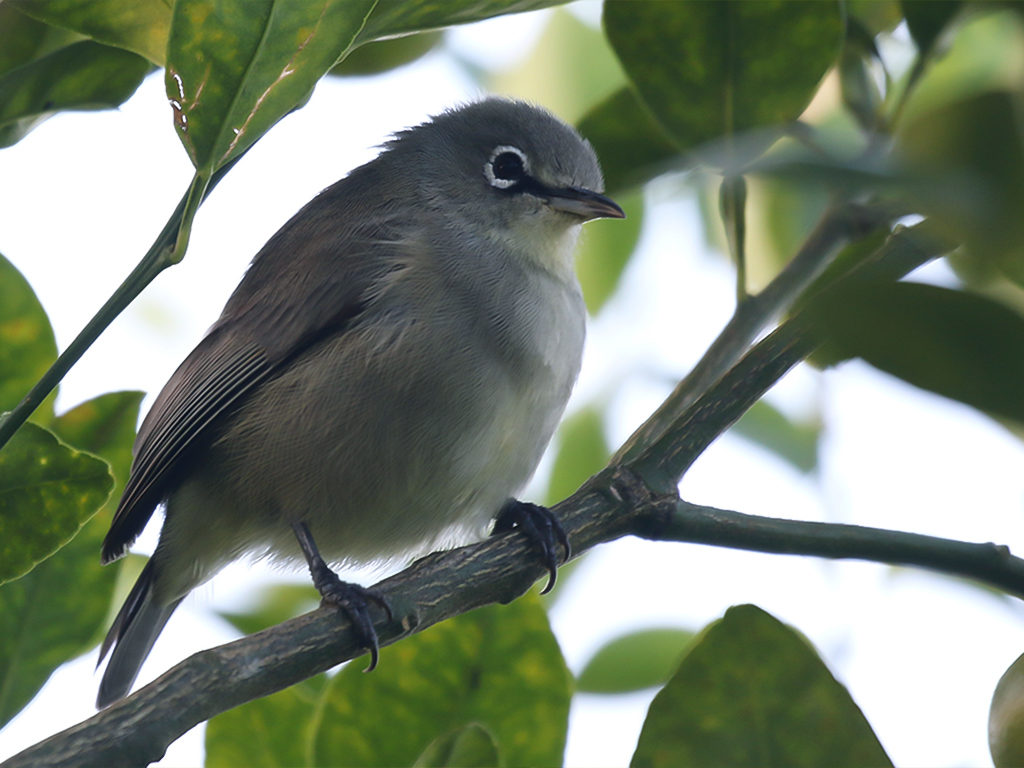
The Seychelles White-Eye is a small rare bird endemic to the Seychelles Islands. It has an olive-grey upper body and duller coloured underparts, measuring 10 – 11 cm in length.
This species was formerly thought to be extinct until its rediscovery in 1991 when it was listed as Vulnerable on IUCN’s Red List of Threatened Species.
It feeds mainly on insects by gleaning them from leaves or catching them midair with their strong wings and feet that have evolved for this purpose.
They can also feed on nectar using their long curved bills which are adapted for probing flowers at night when they become active during twilight hours searching for food sources such as flying fruits and berries.
Breeding season occurs around December where pairs form monogamous relationships building nesting sites together high above ground level often within trees or shrubs providing safety from predators while raising young chicks successfully into adulthood before dispersing again afterwards back into the wild population maintaining genetic diversity among individuals ensuring survival of this beautiful species now classified as vulnerable but yet persisting across these remote islands leading us all hope that one day conservation efforts will see abundance of populations once more throughout its range allowing generations after ours learn about our natural world through stories passed down throughout time regarding. The Seychelles White-Eye Bird.
Scientific classification:
| Kingdom | Animalia |
| Phylum | Chordata |
| Class | Aves |
| Order | Passeriformes |
| Family | Zosteropidae |
| Genus | Zosterops |
| Species | Z. modestus |
6. Seychelles Blue Pigeon
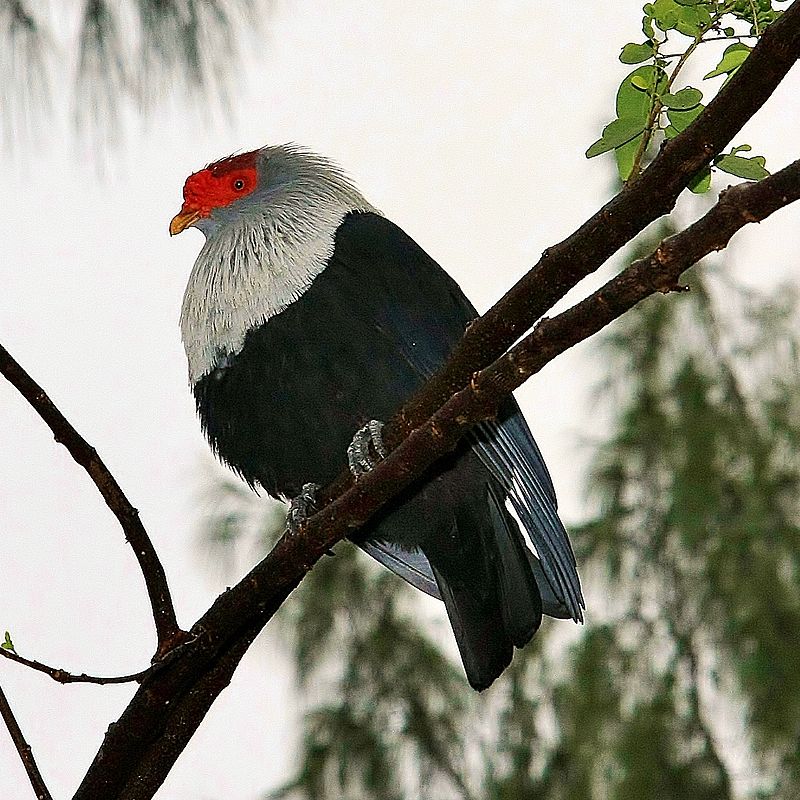
The Seychelles blue pigeon is an impressive bird, with a head and breast of silver-grey feathers that can be raised when the bird is excited.
With a length of around 10 inches (25.4 cm), it inhabits woodland areas across the picturesque Seychelles archipelago in the Indian Ocean.
Its wings are iridescent green and purple, while its back has bright blue feathers which shimmer in sunlight – hence its name.
The species feeds mainly on fruit from trees such as palms and mangoes but also eats insects like caterpillars or moths at night; this helps to maintain healthy ecosystems within their habitats.
It’s believed that these birds mate for life due to their long nesting periods together, making them one of nature’s true romantics.
Scientific classification:
| Kingdom | Animalia |
| Phylum | Chordata |
| Class | Aves |
| Order | Columbiformes |
| Family | Columbidae |
| Genus | Alectroenas |
| Species | A. pulcherrimus |
7. Seychelles Magpie-Robin
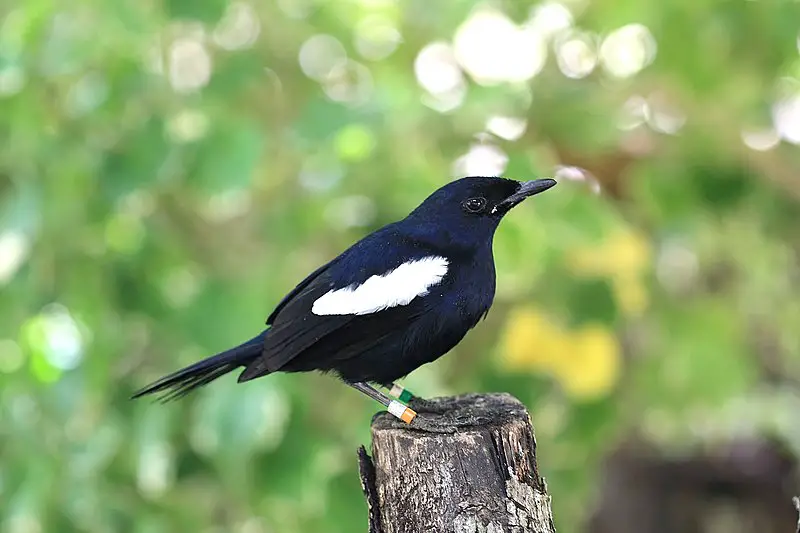
The Seychelles magpie-robin is an endangered bird species from the granitic islands of Seychelles in the Indian Ocean.
It has a medium size, measuring 25 cm (9.8 inches) long and weighing 65 g (2.3 oz) for females and 76 g (2.7 oz) for males – making it one of the largest remnant birds belonging to Muscicapidae family following separation of larger birds.
The upper parts are black with white wings, while its underside is mainly greyish brown or light pinkish buff colouring which may vary depending on age and sex of individual bird species within this group that can be found throughout different regions around Seychelles Islands such as Praslin Island, Silhouette Island etc.
Scientific classification:
| Kingdom | Animalia |
| Phylum | Chordata |
| Class | Aves |
| Order | Passeriformes |
| Family | Muscicapidae |
| Genus | Copsychus |
| Species | C. sechellarum |
8. Aldabra Drongo
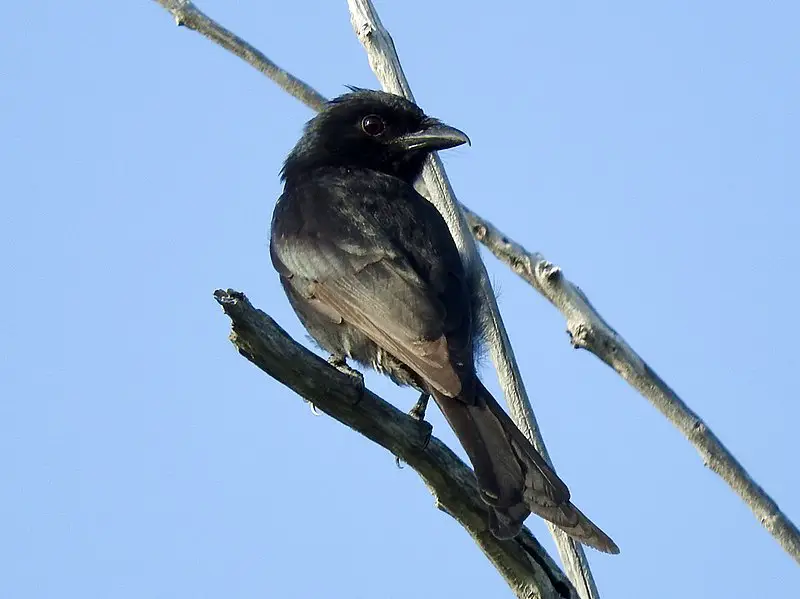
The Aldabra drongo is an endemic species of bird found only on the island of Aldabra in Seychelles. It has a small population size, estimated to be around 1000 birds.
This black-plumaged creature stands out with its heavy bill and bright red eye, while juveniles feature grey backs.
They are quite agile flyers that spend most days perched atop trees looking for food or chasing off intruders from their territory.
These territorial beings sing melodious songs composed by themselves to ward off any possible threats near their nests and also communicate among each other during mating season.
The long tail helps them maneuver through thick foliage when hunting prey like insects, lizards and fruits which form part of their diet.
To ensure survival of this beautiful species it’s important that we protect its habitat by controlling human activities such as deforestation and poaching.
Scientific classification:
| Kingdom | Animalia |
| Phylum | Chordata |
| Class | Aves |
| Order | Passeriformes |
| Family | Dicruridae |
| Genus | Dicrurus |
| Species | D. aldabranus |
9. Sooty Tern
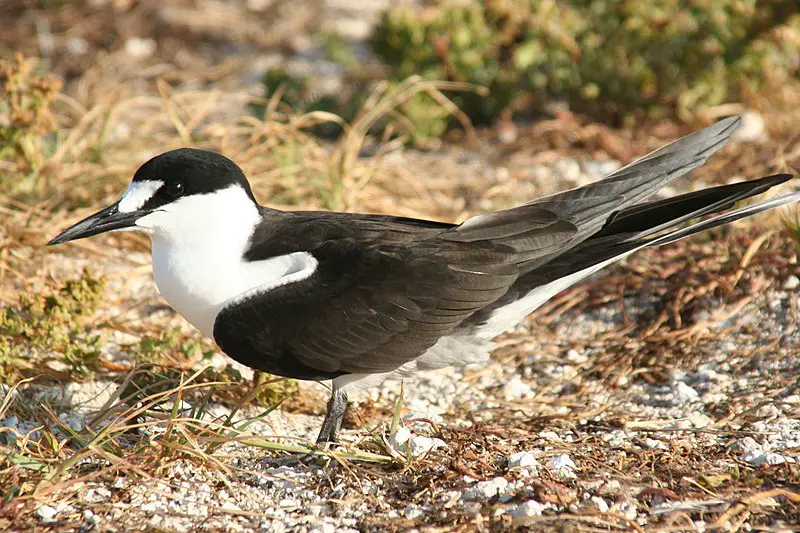
The Sooty Tern is a bird that lives in the tropics of all three major oceans. It is found mostly on remote islands where it returns to nest and breed during its seasonal journeys.
This member of the Laridae family has been described by Carl Linnaeus as Sterna fuscata, though more recently it was given its current name Onychoprion fuscatus.
The sooty tern has dark grey wings and back, with white underneath for camouflage against predators when flying over open ocean waters; they are also adept at diving underwater in search of food such as fish or crustaceans which make up their diet.
They live in colonies and usually lay two eggs each year which incubate for about four weeks before hatching into fluffy little chicks.
Scientific classification:
| Kingdom | Animalia |
| Phylum | Chordata |
| Class | Aves |
| Order | Charadriiformes |
| Family | Laridae |
| Genus | Onychoprion |
| Species | O. fuscatus |
10. White-Throated Rail
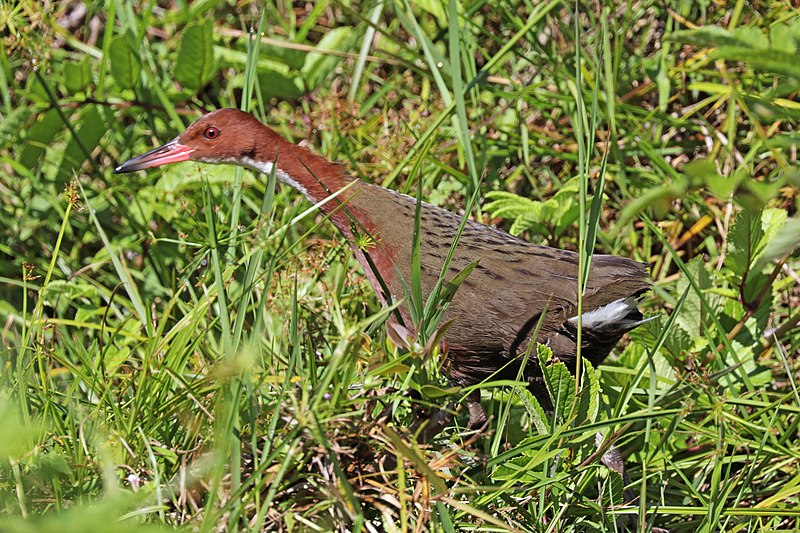
The White-throated rail, also known as Cuvier’s rail, is a species of bird found in the Comoros, Madagascar, Mayotte and Seychelles.
It has two subspecies: one that can fly (the nominate subspecies) that inhabits Madagascar; and another which is flightless or semi-flightless (D. cuvieri aldabranus), located on Aldabra Atoll.
They have white throats with black stripes atop their heads and necks to tell them apart from other Rallidae birds.
The upper parts are grayish brown while its underparts are reddish buff colored.
This species primarily forages in wetlands for insects but will occasionally eat some vegetation as well.
These birds breed during the wet season around November to April at low elevations near water sources such as marshes or swamps so they can find food more easily when raising their young chicks.
Scientific classification:
| Kingdom | Animalia |
| Phylum | Chordata |
| Class | Aves |
| Order | Gruiformes |
| Family | Rallidae |
| Genus | Dryolimnas |
| Species | D. cuvieri |
11. Seychelles Fody
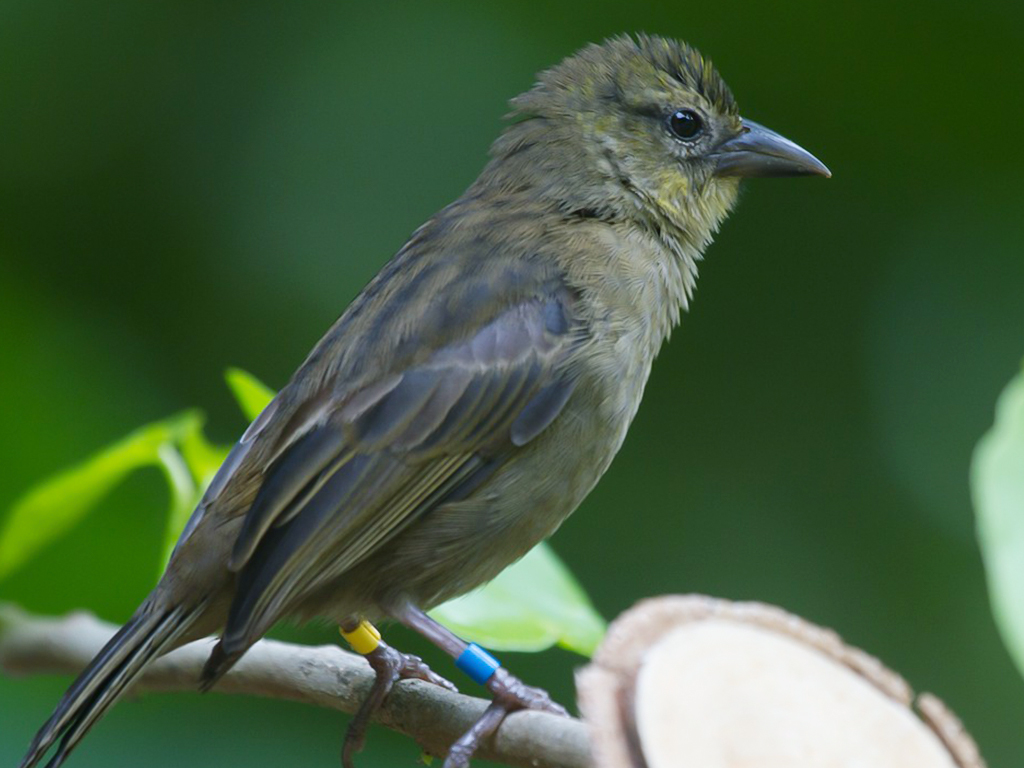
The Seychelles fody is a small yellowish songbird endemic to the islands of Cousin, Cousine, Frégate and Aride. They are known for their adaptability as they can live in various habitats such as woodlands, coconut plantations and gardens.
Male Seychelles Fodies have bright red eyes with black beaks while females have brown eyes with grey-brown beaks.
These birds feed mainly on insects but also eat fruits from time to time. Breeding season starts in October when males start singing loudly to attract mates; during this period male feathers turn more intense orange than usual which helps them stand out even more.
The female lays up 2-3 eggs at a time after building her nest on tree branches or shrubs usually near water sources like ponds or rivers.
All these traits make the Seychelles Fody an interesting species worthy of our attention.
Scientific classification:
| Kingdom | Animalia |
| Phylum | Chordata |
| Class | Aves |
| Order | Passeriformes |
| Family | Ploceidae |
| Genus | Foudia |
| Species | F. sechellarum |
12. Lesser Vasa Parrot
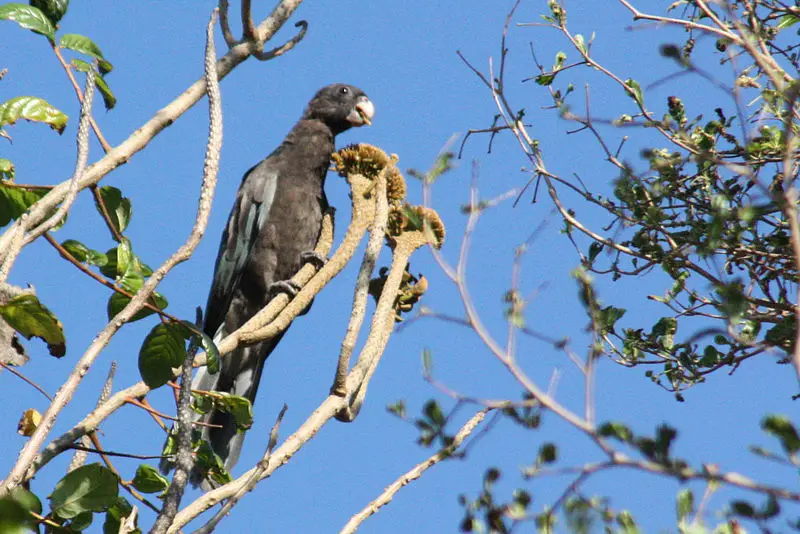
The Lesser Vasa Parrot is a black parrot native to Madagascar. It has three other close relatives, the Greater Vasa, Seychelles Black and Comoros Black Parrots.
These four species are all considered part of the same genus – Coracopsis. The Lesser Vasa Parrot is primarily arboreal and feeds on fruits, seeds and insects in its natural habitat.
They form strong pairs for life that can even be maintained after captivity release back into wild populations.
In addition to this they have an impressive vocal range with some individuals being able to imitate human speech quite clearly making them ideal pet birds as well as attractive ones too.
Scientific classification:
| Kingdom | Animalia |
| Phylum | Chordata |
| Class | Aves |
| Order | Psittaciformes |
| Family | Psittrichasiidae |
| Genus | Coracopsis |
| Species | C. nigra |
13. White-Tailed Tropicbird
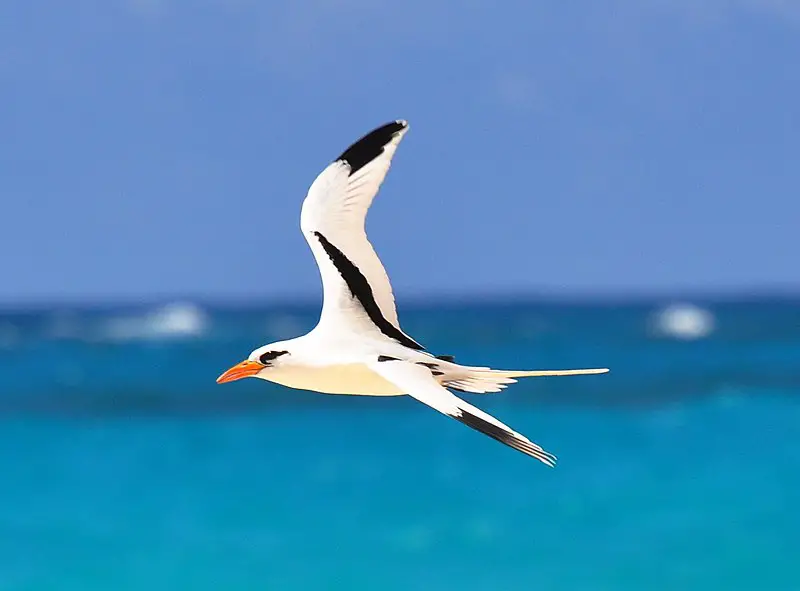
The White-tailed Tropicbird is a beautiful seabird that lives in the tropical waters of the Atlantic, Pacific, and Indian Oceans.
It is the smallest member of its order Phaethontiformes, measuring only 28 inches from head to tail.
Its wingspan can reach up to 45 inches wide. The bird has white plumage with black markings on its wings and tail feathers.
It also has an unmistakable long streamer which trails out behind them when they are in flight – a characteristic feature for all tropicbirds.
They nest mainly on remote islands throughout their range but have recently begun nesting on Little Tobago as well.
These birds feed primarily off flying fish or squid near the ocean’s surface during daylight hours before returning back home at nightfall.
Scientific classification:
| Kingdom | Animalia |
| Phylum | Chordata |
| Class | Aves |
| Order | Phaethontiformes |
| Family | Phaethontidae |
| Genus | Phaethon |
| Species | P. lepturus |
14. Pink-Backed Pelican
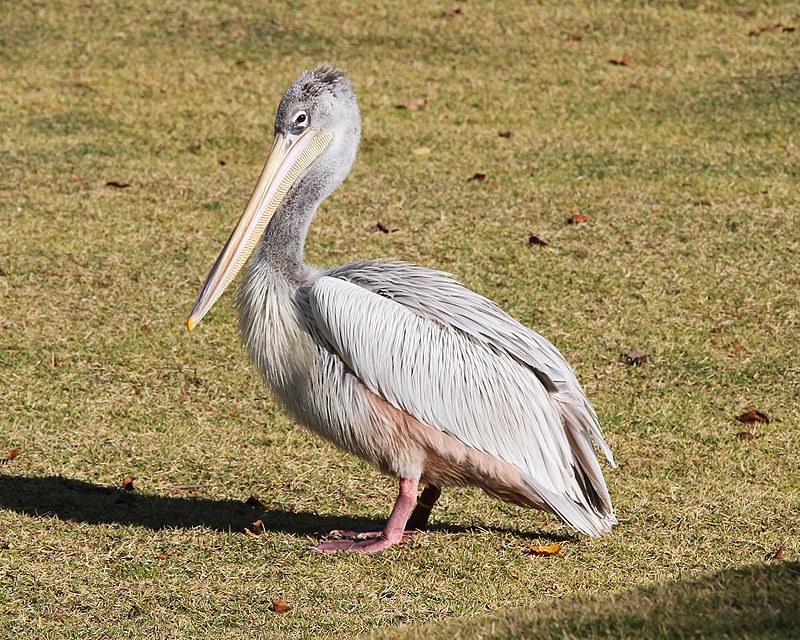
The Pink-backed Pelican is a beautiful bird of the pelican family, found in Africa and southern Arabia.
They are resident breeders that inhabit swamps and shallow lakes, but were once seen in Madagascar as well.
It was formally described by German naturalist Johann Friedrich Gmelin back in 1789.
These birds have unique pink feathers on their backs which gives them their name along with grey or white heads with black wing tips.
They use their long beaks to scoop up fish from the water then drain out excess water before swallowing it whole.
The diet of these birds consists mainly of small fish like anchovies, sardines, and other types offish they can find near the surface of rivers or lakes.
With its long wingspan ranging between 2 – 3 feet (60 – 90 cm), this species has adapted perfectly for gliding over bodies of water while searching for prey to eat.
Scientific classification:
| Kingdom | Animalia |
| Phylum | Chordata |
| Class | Aves |
| Order | Pelecaniformes |
| Family | Pelecanidae |
| Genus | Pelecanus |
| Species | P. rufescens |
15. Seychelles Kestrel
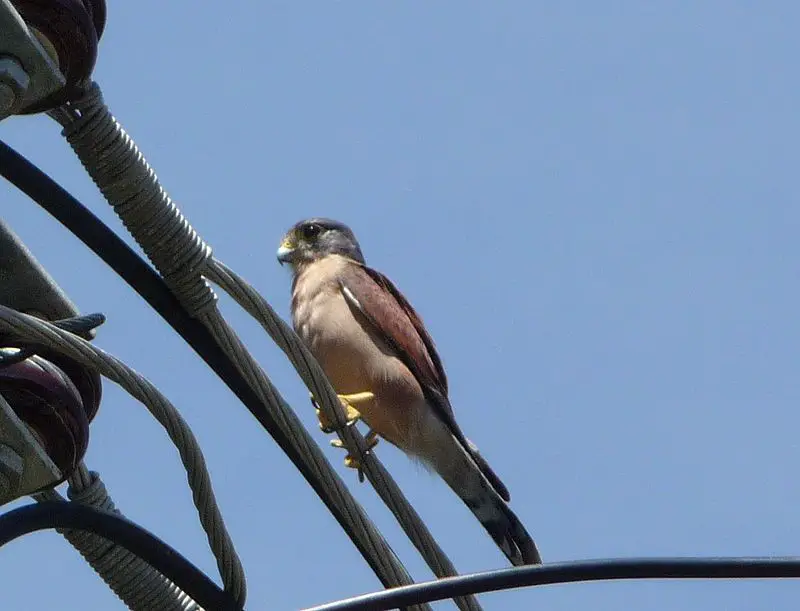
The Seychelles kestrel is a small bird of prey endemic to the Seychelles Islands. It has an unmistakable loud, shrill call in its native Creole language, known as the “katiti”.
Measuring 18–23 cm long with a wingspan of 40–45 cm and fairly short rounded wings, it is the smallest of all kestrels.
The adult birds have two color morphs – one brownish-gray above and white below; while others are darker overall but still display distinct mottling on their backs.
Both sexes have similar plumage patterns and black barring on their tail feathers. They feed primarily insects, lizards or other small vertebrates that they catch by hovering over open areas before swooping down for capture.
However they will also take advantage of available food sources such as garbage dumps around human settlements or dead fish washed up along coastlines during low tide periods.
Despite being listed near threatened due to habitat destruction caused by humans, conservation efforts are helping populations stay stable in recent years giving hope for this unique species’ future survival.
Scientific classification:
| Kingdom | Animalia |
| Phylum | Chordata |
| Class | Aves |
| Order | Falconiformes |
| Family | Falconidae |
| Genus | Falco |
| Species | F. araeus |
16. Seychelles Black Parrot
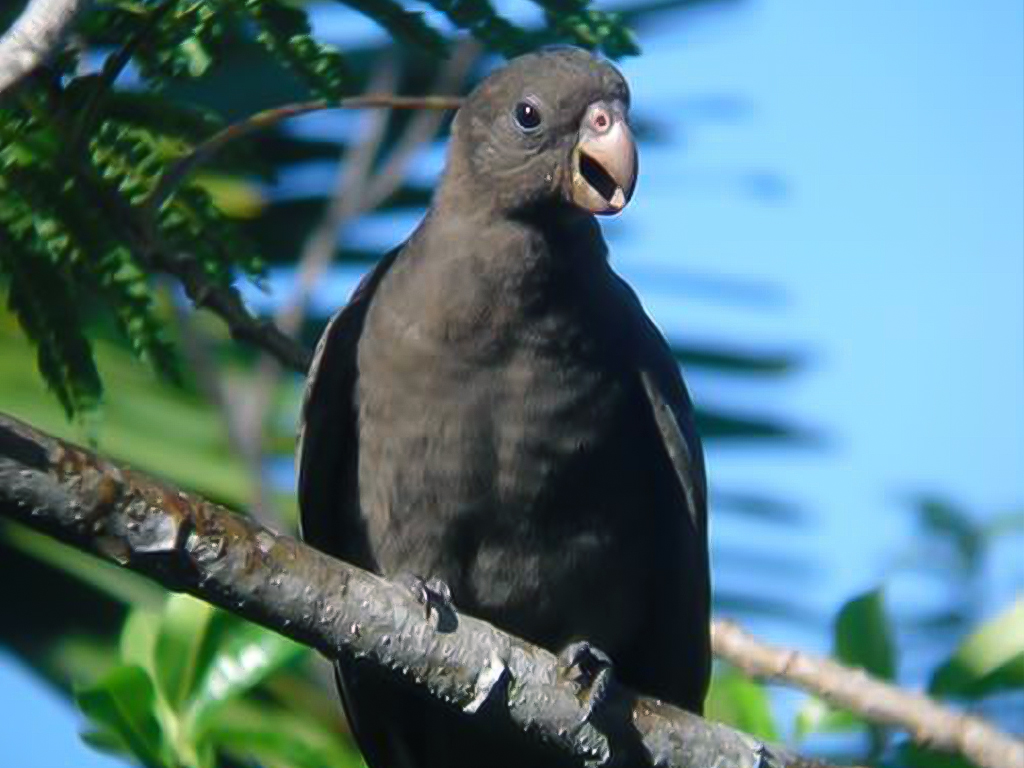
The Seychelles black parrot is a medium-sized, somberly coloured bird endemic to the island nation of Seychelles.
It was previously considered as a subspecies of lesser vasa parrot due to its similar characteristics; however further research reveals that it has been isolated from other species for some time.
The Seychelles black parrots have many unique features including their dark feather colouring and distinct behavioural patterns which make them stand out amongst all other birds in the region.
The population of these beautiful creatures are unfortunately declining due to habitat destruction and illegal hunting practices, so much effort must be made by local conservation groups in order to ensure their continued survival into the future.
Scientific classification:
| Kingdom | Animalia |
| Phylum | Chordata |
| Class | Aves |
| Order | Psittaciformes |
| Family | Psittrichasiidae |
| Genus | Coracopsis |
| Species | C. barklyi |
17. Madagascar Cisticola
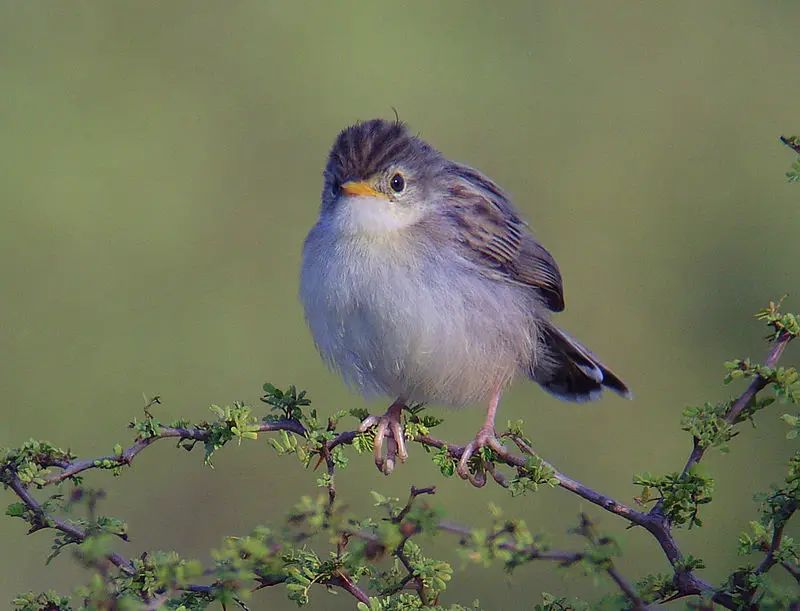
The Madagascar cisticola is a species of bird in the Cisticolidae family. It inhabits areas to the west of the Indian Ocean and forms a superspecies with two other closely related birds.
This small cisticola measures 11 cm long, weighing 8-11 g and has brownish streaked wings, heads and backs coupled with pale underparts.
Its head features an orange crown stripe that contrasts against its gray nape while its throat displays black streaks on yellow feathers.
They have white outer tail feathers which they use as their primary form of communication, along with song whistles used during courtship rituals or territorial disputes.
Their diet consists mainly of insects found among grasses near water sources like ponds or freshwater lakes which provide them protection from predators such as raptors or snakes when roosting at night.
Scientific classification:
| Kingdom | Animalia |
| Phylum | Chordata |
| Class | Aves |
| Order | Passeriformes |
| Family | Cisticolidae |
| Genus | Cisticola |
| Species | C. cherina |
18. Crab-Plover
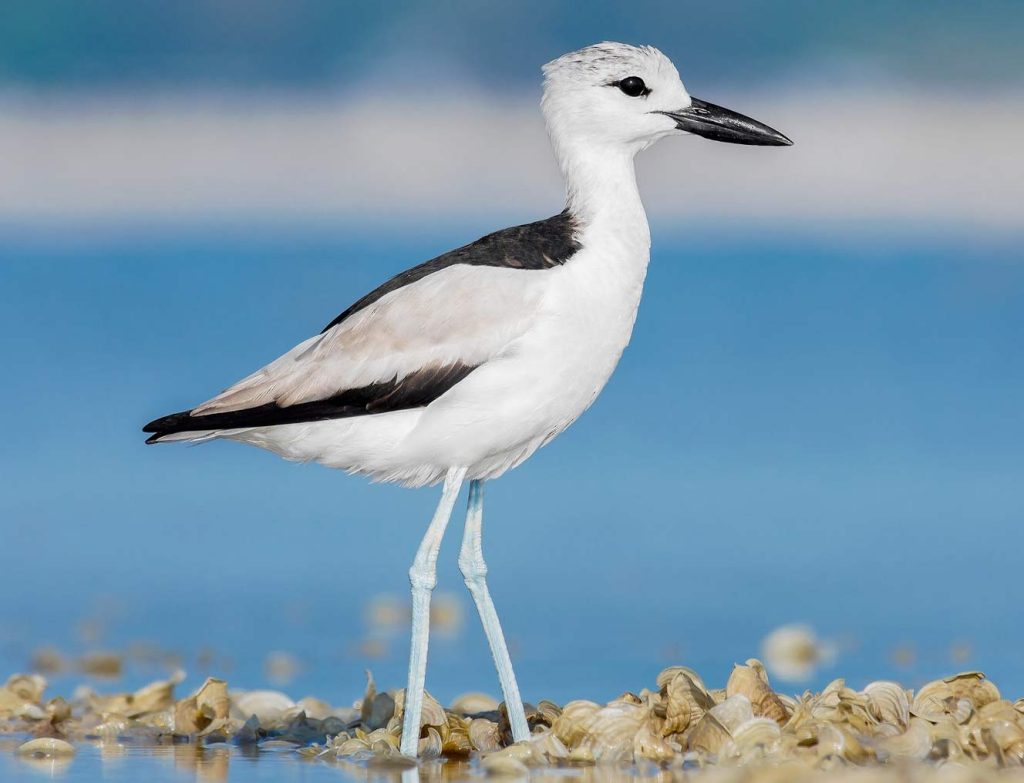
The crab-plover is an exceptional bird which belongs to its own family, Dromadidae. It appears to be closely related to the waders and other Charadriiformes such as auks, gulls and thick-knees.
This species of bird has a unique look; it is white with black markings on its head and wings. Its long bill helps them dig for food in sand or mudflats.
They can also fly up into the air when disturbed by predators or people too close for comfort.
The crab plover spends most of its life near beaches where they feed on crabs, fish eggs and small insects found there.
These birds are highly social during breeding season but solitary at other times throughout their annual cycle making them difficult creatures to spot out in the wild but well worth trying.
Scientific classification:
| Kingdom | Animalia |
| Phylum | Chordata |
| Class | Aves |
| Order | Charadriiformes |
| Suborder | Lari |
| Family | Dromadidae GR Gray, 1840 |
| Genus | Dromas Paykull, 1805 |
| Species | D. ardeola |
19. Malagasy Bulbul
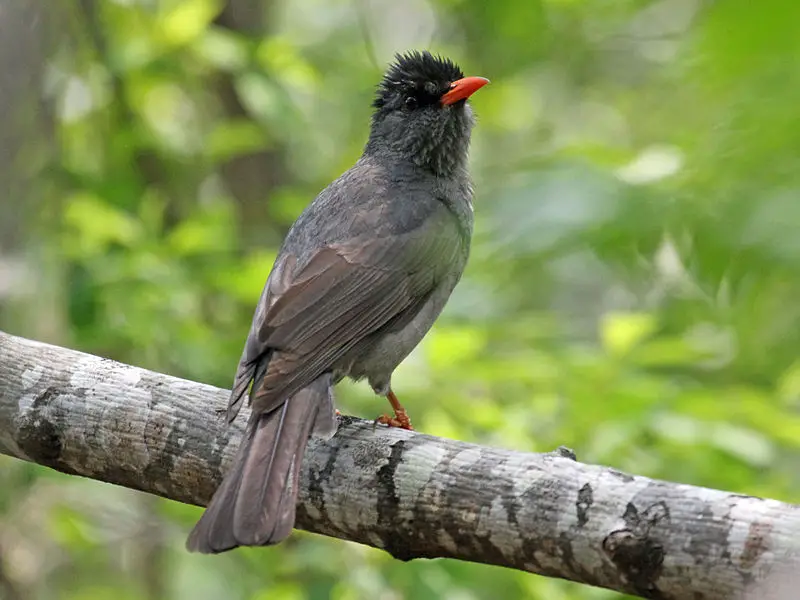
The Malagasy bulbul is a species of songbird belonging to the Pycnonotidae family. It can be found in Madagascar and other nearby islands in the south-western Indian Ocean.
With an alternate name of black bulbul, this bird has black plumage on its upperparts, white underparts and pinkish legs.
Its voice is distinctive with loud whistles which it uses for communication purposes among members of its flock or as warnings against predators.
This beautiful bird feeds mainly on insects but also consumes some fruits like figs from trees or shrubs that grow around their habitat areas.
They prefer moist forests and woodlands where they build nests high up off the ground to protect themselves from potential danger and lay eggs twice a year during certain months depending on location within range countries.
Scientific classification:
| Kingdom | Animalia |
| Phylum | Chordata |
| Class | Aves |
| Order | Passeriformes |
| Family | Pycnonotidae |
| Genus | Hypsipetes |
| Species | H. madagascariensis |
20. Malagasy Coucal
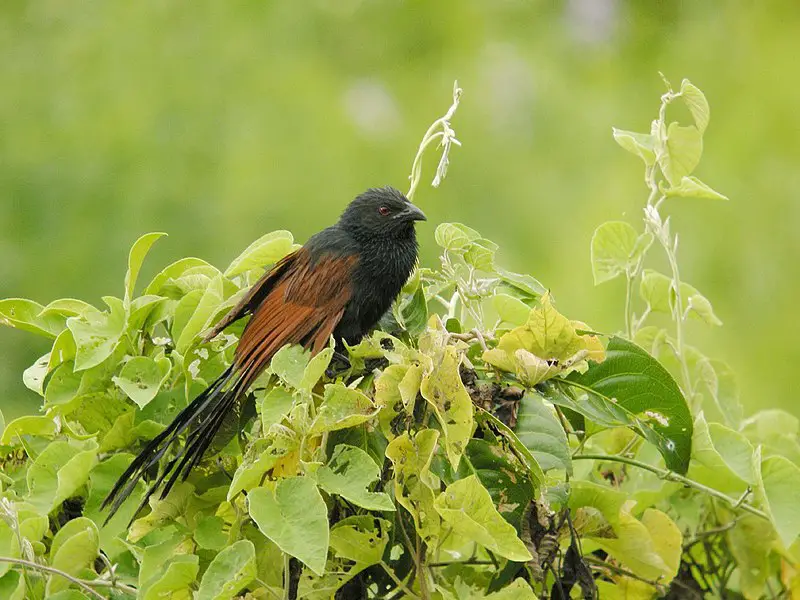
The Malagasy coucal is a species of cuckoo found in Madagascar and the Seychelles. It lives amid dense vegetation, such as subtropical or tropical moist lowland forests, mangrove forests, rough grasslands, marshes and reedbeds.
Its size varies from 28-35 cm long with dark brown upperparts and black underparts. The tail has white tips on its feathers that can be seen when it flies away quickly.
This bird makes loud calls to attract mates during breeding season which usually starts around October/November until April/May every year.
The female lays up to four eggs at once on the ground while both parents take turns incubating them for 14 days before hatching takes place.
All in all this beautiful creature adds an incredible amount of beauty to Madagascar’s wildlife.
Scientific classification:
| Kingdom | Animalia |
| Phylum | Chordata |
| Class | Aves |
| Order | Cuculiformes |
| Family | Cuculidae |
| Genus | Centropus |
| Species | C. toulou |
21. Lesser Frigatebird
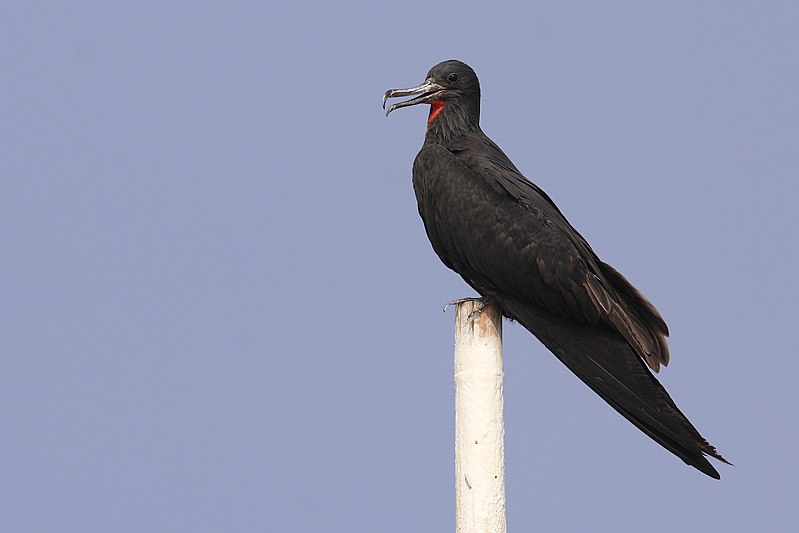
The Lesser Frigatebird is a seabird of the Fregatidae family and is known to be the smallest species in this group. It has brownish-black plumage, long narrow wings, and a forked tail.
This bird inhabits tropical and subtropical regions across the Indian Ocean, Pacific Ocean as well as off Brazil’s Atlantic Coast.
It feeds on fish taken from surface water or by plunge diving while flying low over shallow waters.
Its primary breeding grounds are located around islands with steep cliffs where it builds its nests out of twigs and grasses high up near ledges or crevices.
The lesser frigatebird can live for about 25 years due to their strong aerodynamic abilities which allow them to glide through air currents effortlessly thus conserving energy during flights that last days at a time.
Scientific classification:
| Kingdom | Animalia |
| Phylum | Chordata |
| Class | Aves |
| Order | Suliformes |
| Family | Fregatidae |
| Genus | Fregata |
| Species | F. ariel |
22. White Tern
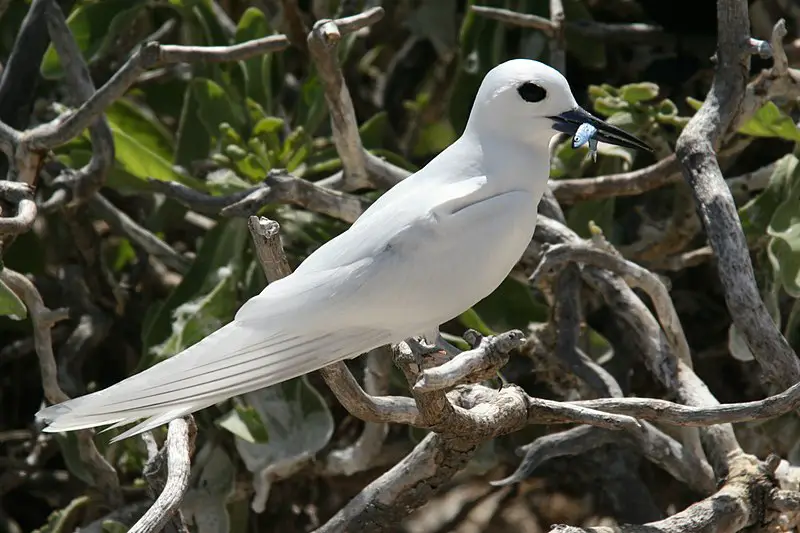
The White tern, also known as the common white tern or Fairy Tern, is a small seabird species found across tropical oceans all over the world.
Known for its elegance and beauty by humans and other animals alike, these birds are truly mesmerizing with their snow-white feathers.
They can be seen soaring in high altitudes or circling around ships at sea looking for food. The Hawaiian name ‘manu-o-Kū’ translates to ‘bird of heaven’ which reflects how majestic this bird looks when it flies through the sky.
These lovely creatures often breed on isolated islands away from predators along with another smaller species called Little White Terns (Gygis microrhyncha).
Scientific classification:
| Kingdom | Animalia |
| Phylum | Chordata |
| Class | Aves |
| Order | Charadriiformes |
| Family | Laridae |
| Genus | Gygis |
| Species | G. alba |
Also Featured In: Most Common Oahu Birds, White Oahu Birds
23. Psittaculidae
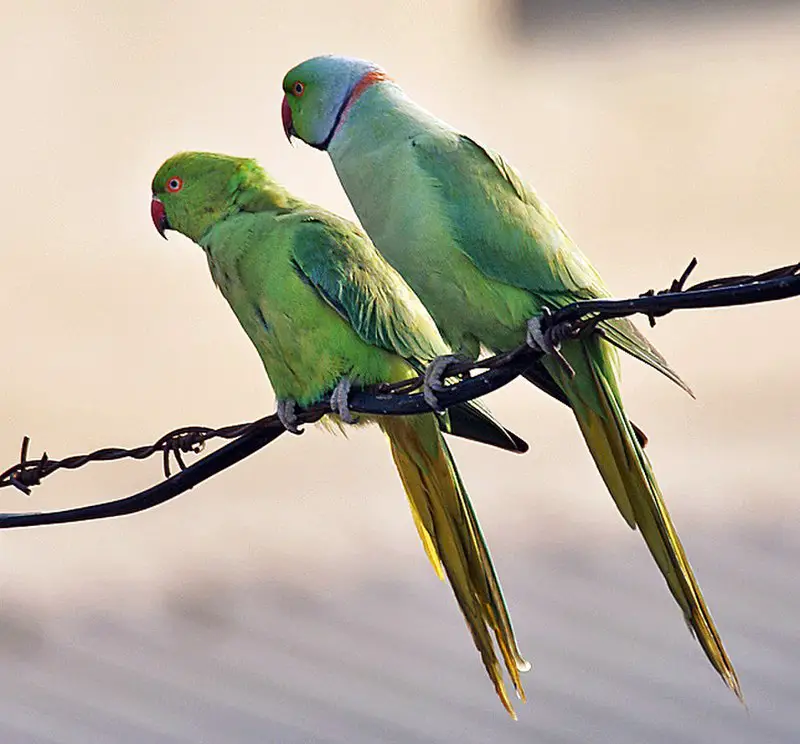
Psittaculidae is a family of Old World parrots that consists of five subfamilies. It includes 192 species divided into 53 genera, and has been accepted by the Clements Checklist of Birds as well as IOC World Bird List.
These birds are known for their bright colours, strong beaks and powerful vocalisations. They can also mimic human sounds including words when taught properly with patience and consistency.
They live in warm climate regions such as Africa, Asia Pacific Islands, Australia and Oceania where they enjoy plentiful food sources like fruits, nuts and seeds in abundance.
Psittaculids are typically found living in groups or pairs instead of alone because they enjoy socialising with others from within their own kind.
Scientific classification:
| Kingdom | Animalia |
| Phylum | Chordata |
| Class | Aves |
| Order | Psittaciformes |
| Superfamily | Psittacoidea |
| Family | Psittaculidae Vigors, 1825 |
24. Malagasy Kingfisher
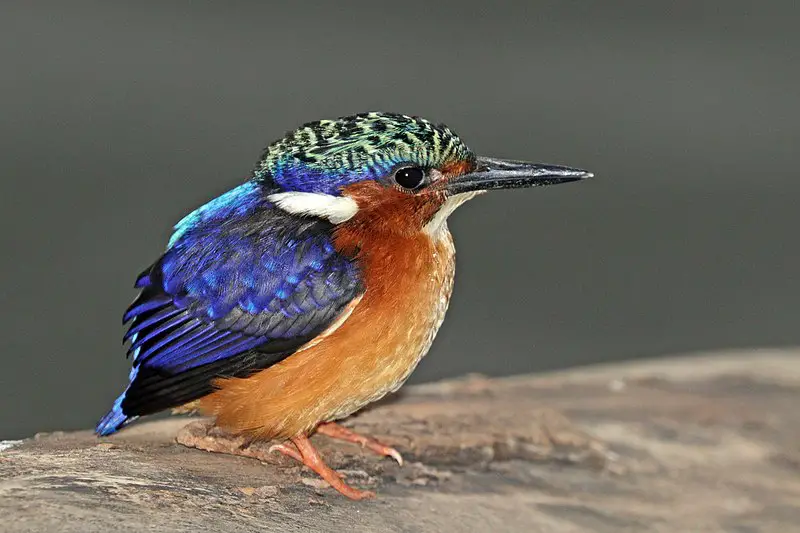
The Malagasy kingfisher is a species of bird in the family Alcedinidae that can be found inhabiting mangrove forests in Madagascar, Mayotte and the Comoros.
It was first described by French naturalists Joseph Eydoux and Paul Gervais back in 1836.
This small songbird has an average length between 11-12 cm long with blue wings, head and breast along with black markings on its eye line which extends to its nape giving it a distinguished look.
They have pale underparts as well as bright orange legs and feet. The Malagasy Kingfisher feeds mainly on insects but will also eat some smaller fish or crustaceans if available near their habitat areas.
Moreover, they are usually quite shy birds who prefer solitude however during breeding season these birds form pairs to nest together.
All things considered ,the Malagasay Kingfishers are one of Madacascar’s most beautiful avian residents.
Scientific classification:
| Kingdom | Animalia |
| Phylum | Chordata |
| Class | Aves |
| Order | Coraciiformes |
| Family | Alcedinidae |
| Subfamily | Alcedininae |
| Genus | Corythornis |
| Species | C. vintsioides |
25. Austral Storm Petrels
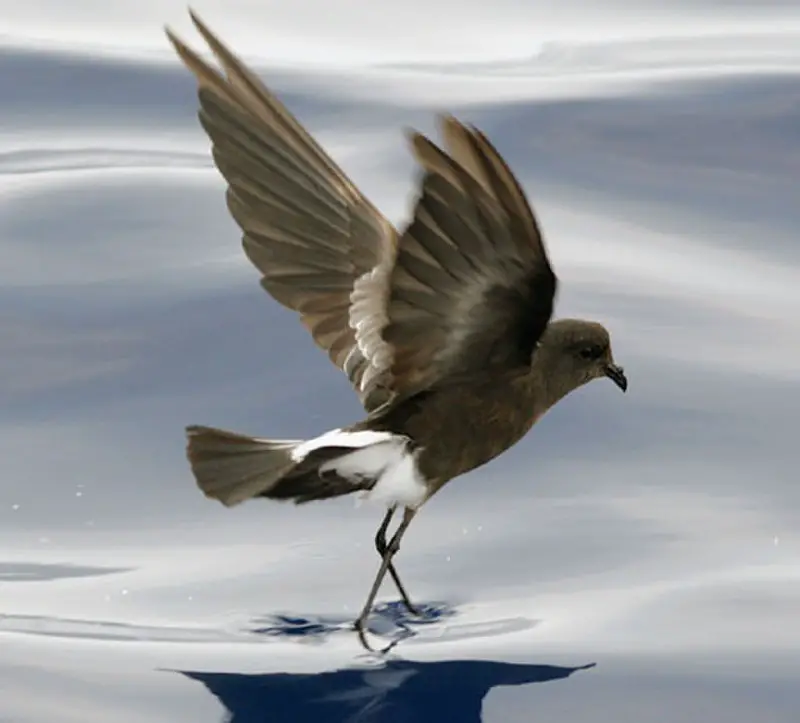
Austral Storm Petrels are the smallest of seabirds, belonging to the family Oceanitidae and order Procellariiformes.
They have a cosmopolitan distribution across all oceans, with their flight being fluttering and sometimes bat-like in appearance.
These birds feed on planktonic crustaceans as well as small fish that they pick from the surface while hovering over it.
Their plumage is mostly dark grey or blackish brown above; underparts may be white or mottled gray.
The feet vary between species but usually have pale yellow webs and claws which help them move easily through water when searching for food.
Austral storm petrels often make nests on remote islands where these birds can breed safely without any disturbances from humans during their nesting season.
Scientific classification:
| Kingdom | Animalia |
| Phylum | Chordata |
| Class | Aves |
| Order | Procellariiformes |
| Family | Oceanitidae Forbes, 1881 |
26. Seychelles Parakeet
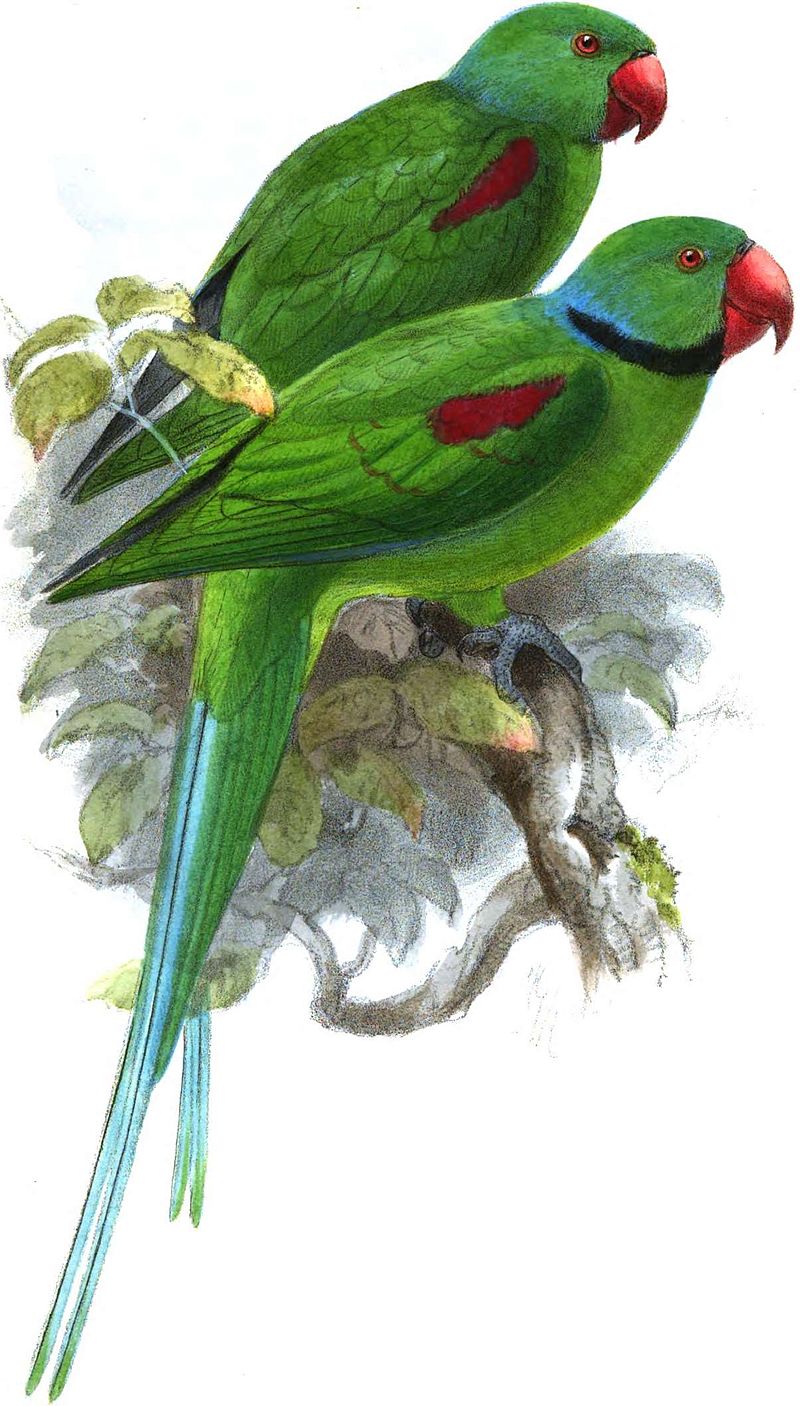
The Seychelles parakeet, a species of parrot native to the Indian Ocean archipelago of Seychelles, is now extinct.
It was scientifically named Palaeornis wardi after the British civil commissioner Swinburne Ward who collected specimens used for its description in 1867.
The bird had green plumage with blue-tipped wings and tail feathers as well as an orange beak and white ring around its eyes.
Unfortunately, it became critically endangered due to habitat destruction caused by human activities such as deforestation and hunting before finally going extinct sometime between 1870–1900 despite conservation efforts from authorities at that time.
Scientific classification:
| Kingdom | Animalia |
| Phylum | Chordata |
| Class | Aves |
| Order | Psittaciformes |
| Family | Psittaculidae |
| Genus | Psittacula |
| Species | †P. wardi |
27. Seychelles Swiftlet
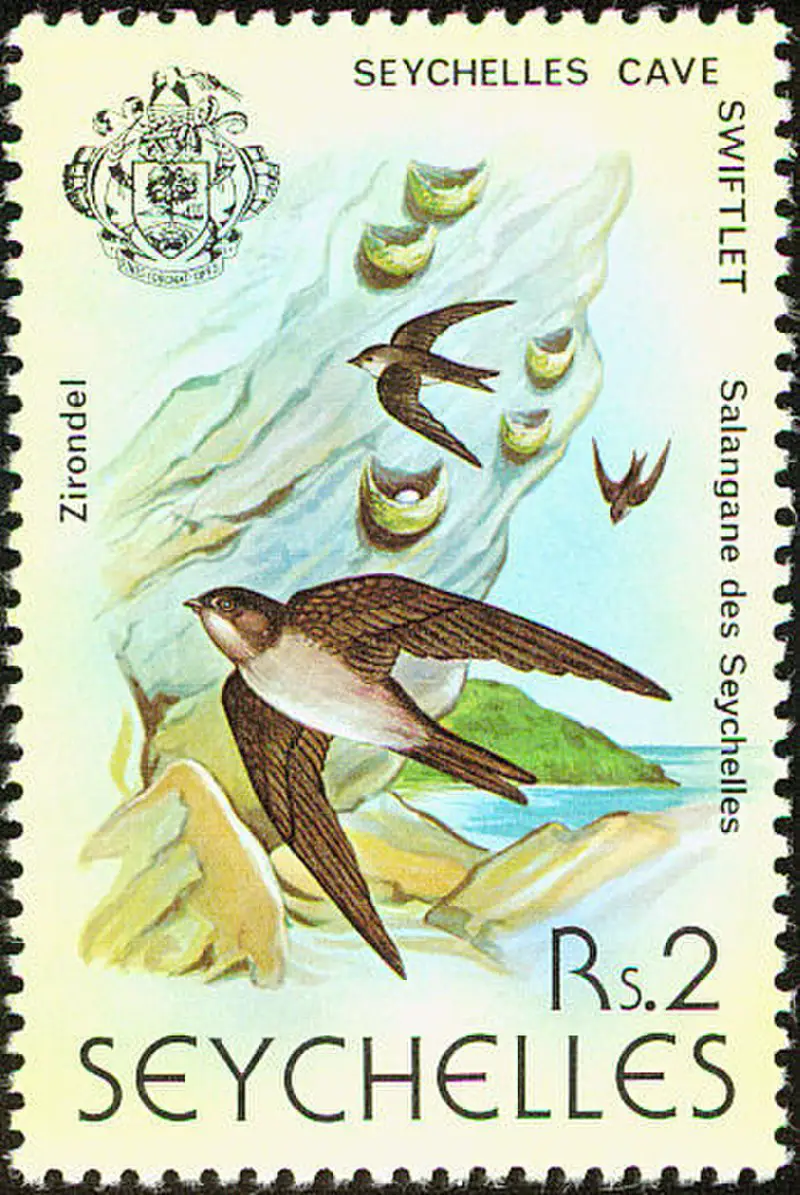
The Seychelles swiftlet is a small bird that can only be found in the Seychelles Islands of the Indian Ocean. It measures 10-12 cm long with a wingspan of 28 cm and weighs about 10 g.
Its colors range from dark grey-brown on its upperparts to paler browns on its under parts, while it has black bill and legs. The tail is forked shaped and also darker than other body parts.
This species lives mainly in coastal areas where they build their nests inside caves or rock crevices using saliva as building material; however, some may also reside inland near human settlements such as villages or townships.
They feed mostly during evening hours on insects which are caught midair by flying fast around trees.
Scientific classification:
| Kingdom | Animalia |
| Phylum | Chordata |
| Class | Aves |
| Order | Apodiformes |
| Family | Apodidae |
| Genus | Aerodramus |
| Species | A. elaphrus |
28. Roseate Tern
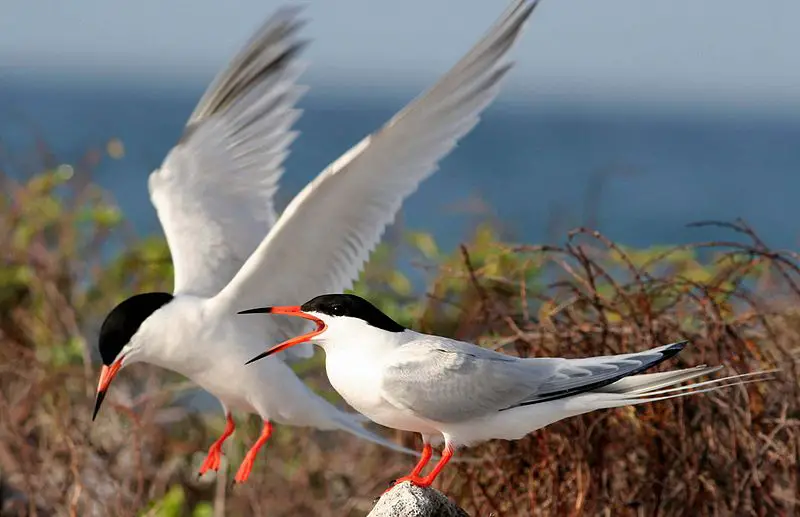
The Roseate Tern (Sterna dougallii) is a species of bird that belongs to the family Laridae. It gets its name from its pink breast in breeding plumage, which gives it a “roseate” appearance.
The genus Sterna comes from Old English and means “tern” while the specific dougallii refers to Scottish physician and collector Dr Peter McDougall (1777–1814).
This species was first described by George Montagu in 1813.
They are most common near coasts but can be found further inland occasionally too. These birds mainly feed on small fish like sardines, anchovies or herring as well as crustaceans when available.
They typically lay two eggs each year during their breeding season between May-September before migrating south for winter months.
Scientific classification:
| Kingdom | Animalia |
| Phylum | Chordata |
| Class | Aves |
| Order | Charadriiformes |
| Family | Laridae |
| Genus | Sterna |
| Species | S. dougallii |
29. Malagasy Sacred Ibis
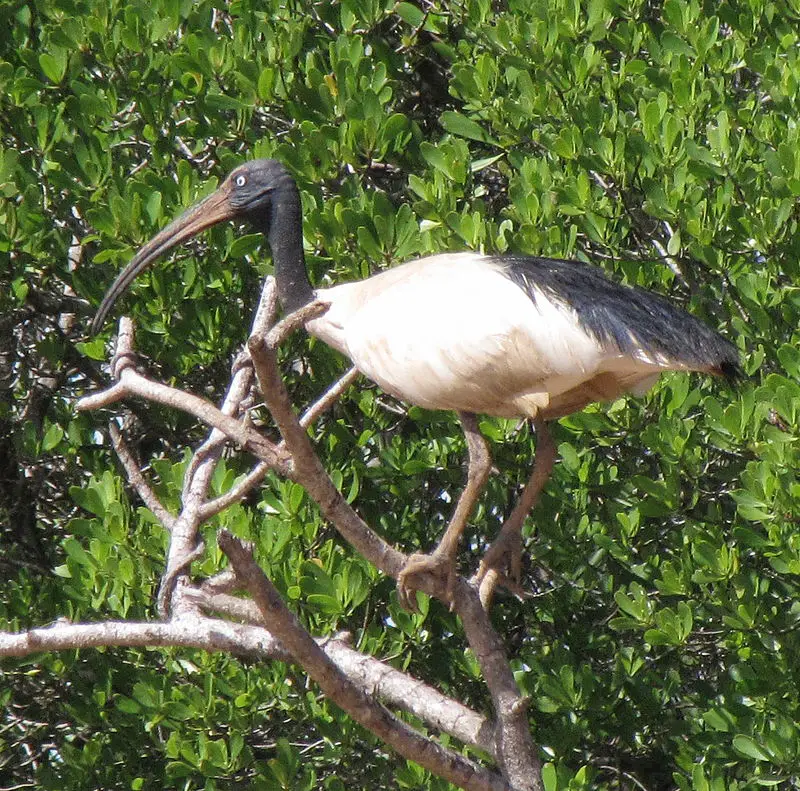
The Malagasy sacred ibis is a striking species of bird native to Madagascar and Aldabra on the Seychelles.
It was formerly thought to be a subspecies of the African Sacred Ibis, but its distinct features such as heavily built body structure have since been recognised as unique.
The colouring of this species has also seen it classified separately; with its black plumage offset by white primary flight feathers, yellow legs and greyish bill.
This makes for an impressive sight when in flight. In addition to their physical differences from other ibises, these birds are also known for their cultural significance within Madagascar where they were once believed to embody ancestral spirits that brought good fortune upon families who worshipped them.
Scientific classification:
| Kingdom | Animalia |
| Phylum | Chordata |
| Class | Aves |
| Order | Pelecaniformes |
| Family | Threskiornithidae |
| Genus | Threskiornis |
| Species | T. bernieri |
30. Comoros Blue Pigeon
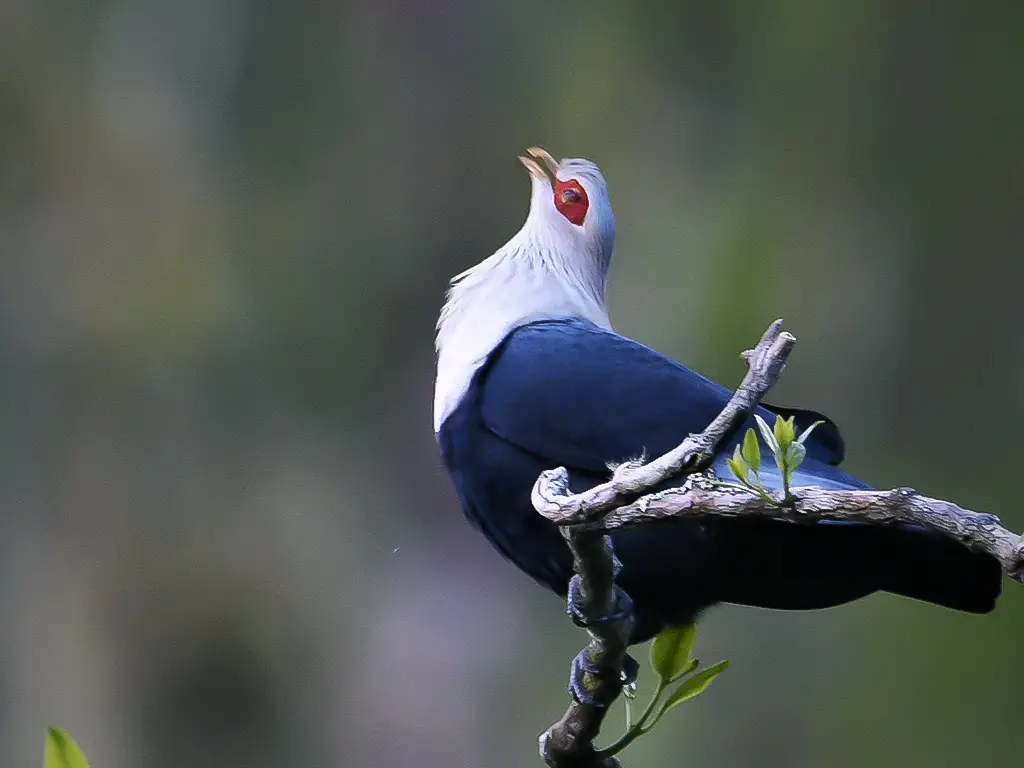
The Comoros blue pigeon is a species of bird found in the family Columbidae, and it is endemic to the Comoros and coralline Seychelles. It has been classified as near threatened on the IUCN Red List due to its declining population.
This small bird measures 27 cm long with males typically weighing between 134-158 grams while females are slightly lighter.
This species has an iridescent greenish-blue plumage which makes them easily recognizable in their natural habitat among other birds.
They have a white patch around their eyes that contrast against their black beak and feet, both of which aid foraging for food such as seeds, fruits, grains and insects from trees or bushes within forests or grasslands.
The conservation status of this species needs attention since they rely heavily on intact habitats for survival; therefore any destruction can lead to further declines in numbers if not addressed adequately soon enough.
Scientific classification:
| Kingdom | Animalia |
| Phylum | Chordata |
| Class | Aves |
| Order | Columbiformes |
| Family | Columbidae |
| Genus | Alectroenas |
| Species | A. sganzini |
32. Lesser Noddy
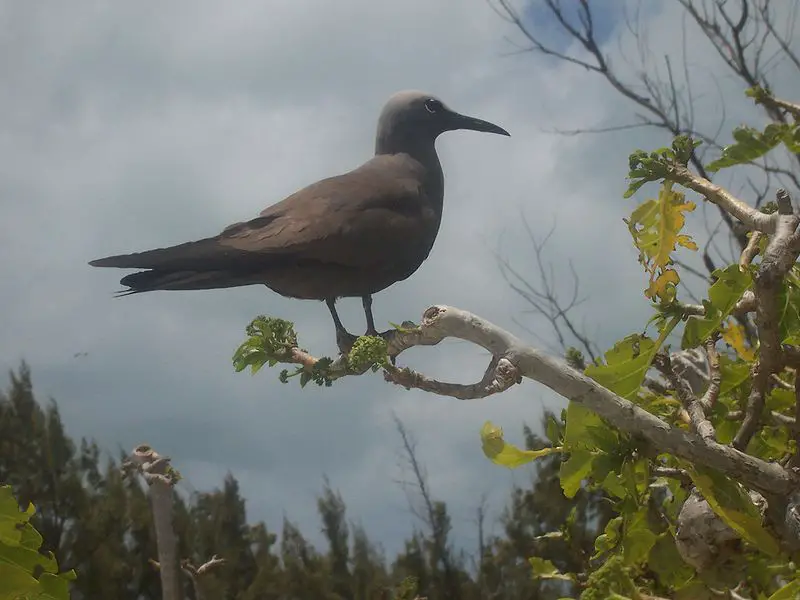
The Lesser Noddy is a seabird found near the coastlines of several countries in the Indian Ocean.
It has distinctive black feathers and was once thought to be related to its cousin, the Black Noddy.
The two share many similarities such as appearance, behavior and habitat preferences but have been confirmed as separate species.
They typically feed on small fish or invertebrates near shoreline areas like coral reefs or mangroves forests.
Breeding season usually occurs during springtime when they build nests out of plant material high up in trees close to water sources.
These birds are important for maintaining balance within their local ecosystems by helping recycle nutrients from sea creatures into land organisms via droppings released onto coastal vegetation systems which can help regenerate new growths over time.
Scientific classification:
| Kingdom | Animalia |
| Phylum | Chordata |
| Class | Aves |
| Order | Charadriiformes |
| Family | Laridae |
| Genus | Anous |
| Species | A. tenuirostris |
33. Black-Naped Tern
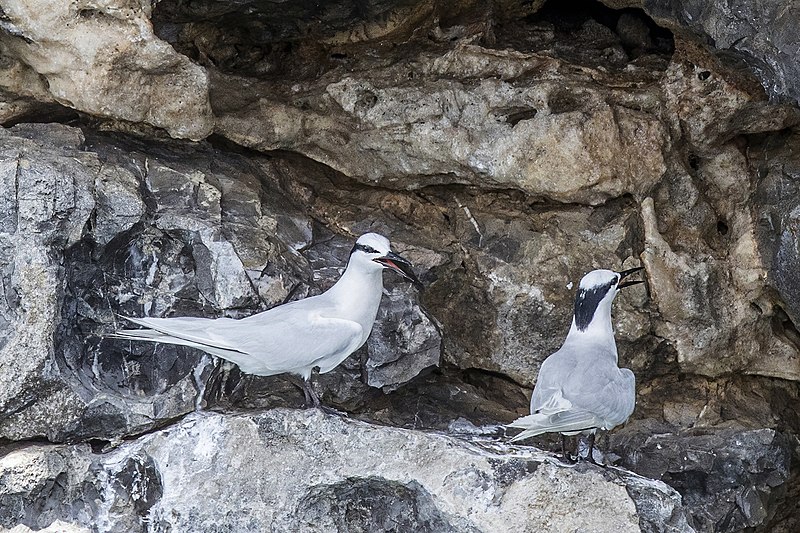
The beautiful Black-naped Tern is a seabird found in tropical and subtropical areas of the Pacific and Indian Oceans.
These terns measure around 30 cm long, with a wing span of 21 to 23 cm, black beaks and legs, yellow bill tips, long forked tails and white faces.
The breast has grayish-white feathers that extend down its back – forming an elegant nape hence their name.
They are rarely seen inland but they can stay close to coastal waters or even venture further out depending on seasonal changes.
Their diet consists mainly of fish which they hunt from above by hovering before plunging into the sea at high speed after prey. They also feed on crustaceans sometimes too.
All in all these birds have an interesting lifestyle; incredibly graceful when airborne yet ferocious hunters underwater making them quite a sight.
Scientific classification:
| Kingdom | Animalia |
| Phylum | Chordata |
| Class | Aves |
| Order | Charadriiformes |
| Family | Laridae |
| Genus | Sterna |
| Species | S. sumatrana |
34. Brown Noddy
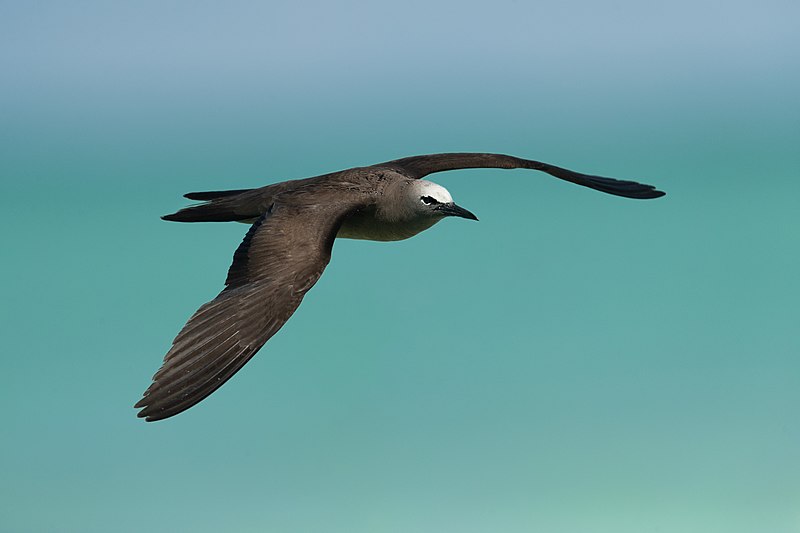
The Brown Noddy is a species of seabird in the Laridae family. It’s the largest of its kind, and can be distinguished from others by its dark brown plumage, which stands out compared to other noddies with black feathers.
Found around tropical oceans worldwide, it inhabits areas such as Hawaii and Australia all the way to Tuamotu Archipelago in Polynesia.
During breeding season they form large colonies on remote islands where their nests are constructed using twigs and leaves situated atop trees or shrubs – typically located near water sources like lagoons or estuaries so they have access to food items like small fish and squid that make up their diet.
As highly social birds they often engage in synchronised flying displays over nesting sites before returning back home at nightfall.
Scientific classification:
| Kingdom | Animalia |
| Phylum | Chordata |
| Class | Aves |
| Order | Charadriiformes |
| Family | Laridae |
| Genus | Anous |
| Species | A. stolidus |
35. Telluraves
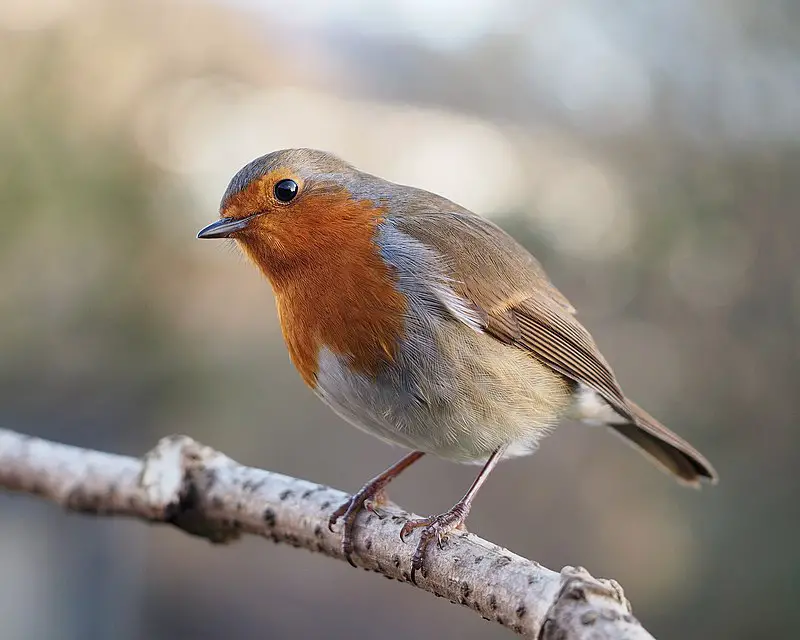
Telluraves are a recently identified clade of birds, which can be distinguished by their arboreal lifestyle. They include the australavians, such as passerines, parrots and falcons; and afroavians – eagles, hawks, buzzards and vultures.
This diverse group is united genetically thanks to recent studies showing they share similar DNA sequences.
Telluraves are an important part of many ecosystems around the world due to their essential roles in pollination or predation on other animals that form part of food webs.
These landbirds have various adaptations for life amongst trees including strong claws for clinging onto branches while hunting or nesting; large wings suited to soaring over wide areas; long tails aiding maneuverability whilst flying between trees.
Crests used both in courtship displays and species recognition within flocks; stout bills adapted for tearing prey apart quickly when feeding young chicks at nests high up from predators below.
Scientific classification:
| Kingdom | Animalia |
| Phylum | Chordata |
| Class | Aves |
| Clade | Neoaves |
| Clade | Passerea |
| Clade | Telluraves Yuri et al., 2013 |
Also Featured In: Birds That Live In Tristan da Cunha,
36. Greater Sand Plover
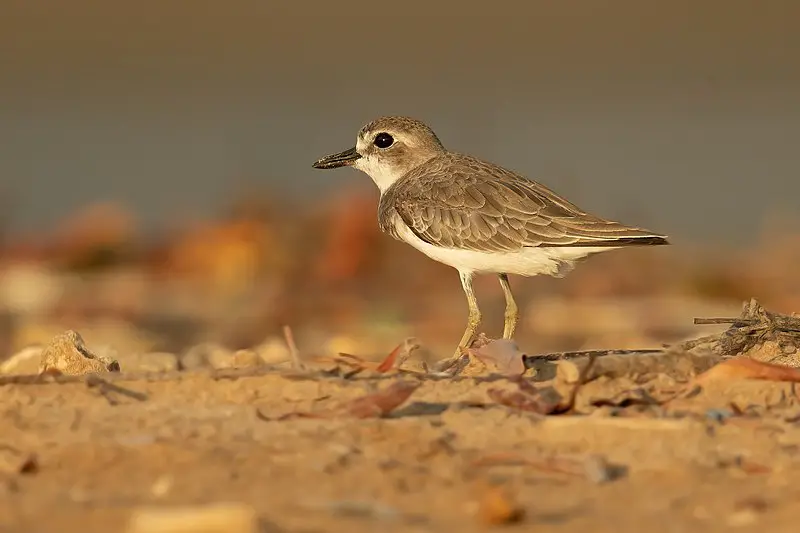
The Greater Sand Plover is a small wader, belonging to the plover family of birds. It’s scientific name Charadrius leschenaultii comes from the Latin word for a yellowish bird mentioned in the 4th century Vulgate.
These birds are typically found along coasts and sandy beaches where they feed on insects, mollusks and crustaceans.
They have grey-brown upperparts with white underparts and characteristic black bands across their chest as well as a prominent white forehead patch.
The Greater Sand Plovers breed mainly in India, Southeast Asia, Northern Australia and New Guinea while migrating to wintering grounds at coasts around South East Asia during nonbreeding season.
This species relies heavily on coastal wetlands so it is essential that these habitats be preserved in order for this species to survive into future generations.
Scientific classification:
| Kingdom | Animalia |
| Phylum | Chordata |
| Class | Aves |
| Order | Charadriiformes |
| Family | Charadriidae |
| Genus | Charadrius |
| Species | C. leschenaultii |
37. Lesser Sand Plover
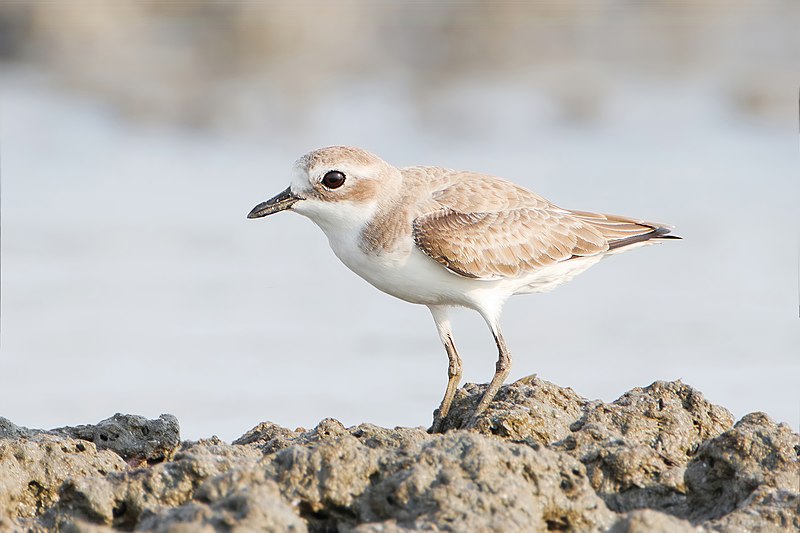
The Lesser Sand Plover is a small wader bird belonging to the plover family. It has yellowish-brown upperparts and white underparts, with a distinct black band across its chest and whitish forehead.
Its wings are short but powerful, allowing it to cover large distances in search of food such as insects, worms or crustaceans found on muddy beaches or shallow lagoons near coasts.
The species prefers habitats with low vegetation like sandy deserts, coastal dunes and salt flats where they can hide among the sand grains while foraging for food during their migrations between Africa and Asia.
These birds form monogamous pairs that breed annually in springtime; nests consist of scrapes made on the ground lined with pebbles or shells carefully arranged by both parents who will vigorously defend them against predators until chicks fledge after about four weeks from hatching.
Scientific classification:
| Kingdom | Animalia |
| Phylum | Chordata |
| Class | Aves |
| Order | Charadriiformes |
| Family | Charadriidae |
| Genus | Charadrius |
| Species | C. mongolus |
38. Wedge-Tailed Shearwater
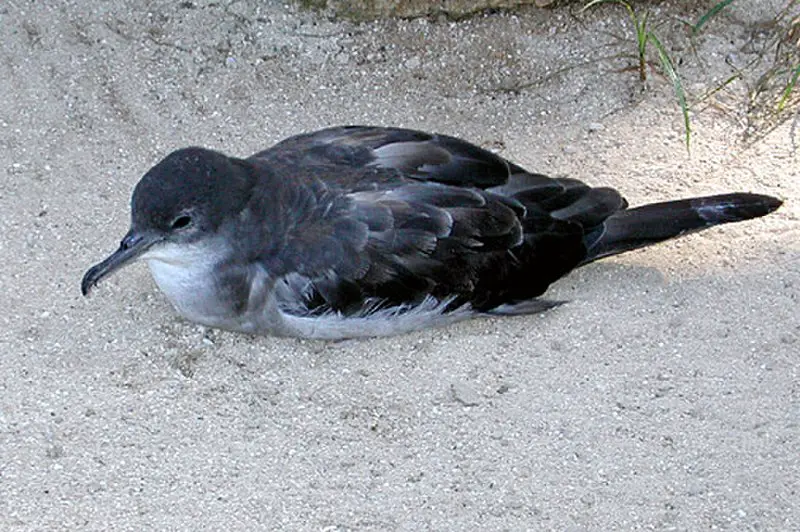
The wedge-tailed shearwater is a medium-large seabird found in the tropical Pacific and Indian Oceans. It is one of several species referred to as muttonbirds, along with the sooty and short-tailed shearwaters.
These birds have long wings that allow them to soar for extended periods over large bodies of water while searching for food such as fish, squid, crustaceans, cephalopods and other marine invertebrates.
During mating season they nest on islands or small sandy beaches where both parents take turns caring for their chicks until they fledge at around two months old.
Wedge-taileds are an important part of many island cultures who traditionally hunt these birds during certain times of year when populations peak due to migration patterns.
Scientific classification:
| Kingdom | Animalia |
| Phylum | Chordata |
| Class | Aves |
| Order | Procellariiformes |
| Family | Procellariidae |
| Genus | Ardenna |
| Species | A. pacifica |
Also Featured In: Birds that Live in the Ocean , Birds that Live in Gold Coasts
39. Fody
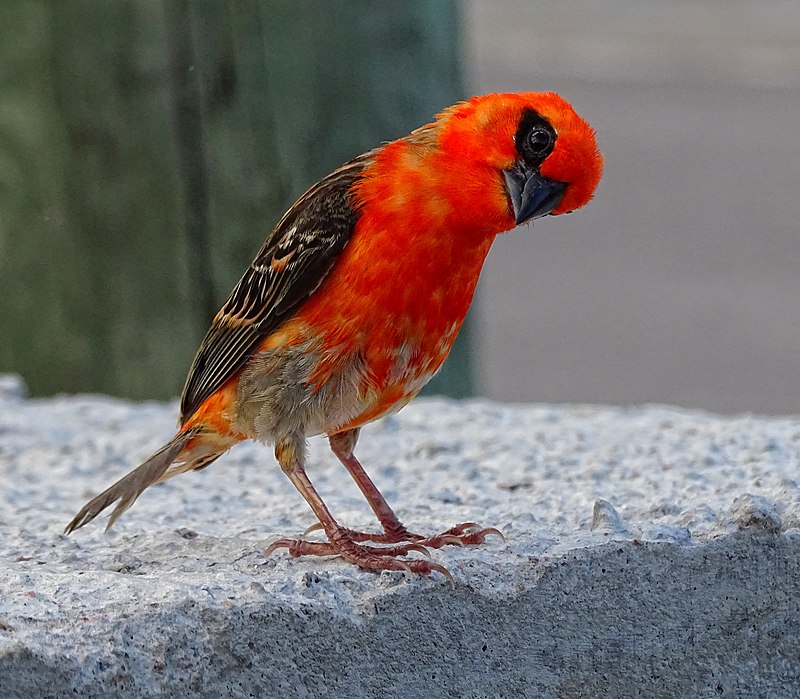
The Fody is a small passerine bird belonging to the weaver family Ploceidae. It is about 12-15 cm long and has a short, conical bill.
In breeding plumage, males are usually brightly coloured with red or yellow on their heads and sometimes other parts of their bodies.
Non-breeding males and females have dull grey-brown plumage like sparrows. They inhabit dry woodlands in Madagascar, Comoros islands and East Africa, where they feed mostly on insects such as grasshoppers and beetles which they hunt by jumping from branch to branch in trees.
The nest made of woven grasses lined with feathers is built near the top of tall tree canopies away from predators’ reach.
Overall these birds make great additions to any backyard garden.
Scientific classification:
| Kingdom | Animalia |
| Phylum | Chordata |
| Class | Aves |
| Order | Passeriformes |
| Family | Ploceidae |
| Genus | Foudia Reichenbach, 1850 |